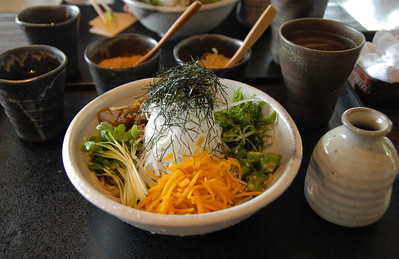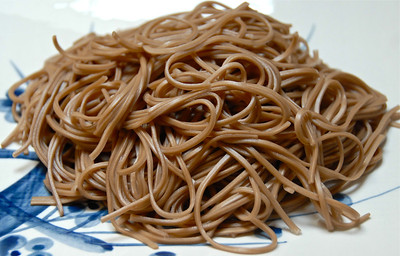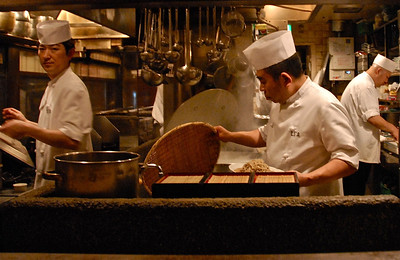
When I told friends that I’d be traveling to Japan last month, the first or, depending on the person’s love of manga, Godzilla movies or Hello Kitty, second thing mentioned was sushi. Eyes lit up with thoughts of velvety, coral-colored toro blanketing perfectly made beds of vinegared white rice. Although I love sushi, I had a different culinary mission for Japan. As soon as the plane touched down in Tokyo, I went on a hunt for soba.
The name for the thin, grayish-tan noodles as well as the buckwheat flour from which they’re made, soba has long been a favorite food. It has a warm, earthy flavor, nutty aroma and firm texture that I adore. I likewise appreciate that it can be eaten hot or cold, with or without stocks or sauces and on its own or with meats, herbs and/or vegetables atop it. Plus, it’s loaded with nutrients and a decent source of vitamins B, C and E and protein. What’s not to love?

Once in Japan, I didn’t have to look long or hard for my quarry. Consumed since ancient times, soba is especially popular in the country’s northeast region, which includes Tokyo. It’s a food consumed not only in every day life but also on special occasions such as New Year’s Eve and when meeting new neighbors. The long noodles are said to represent long, happy lives and relationships.
I had my first taste of Japanese soba at Meigetsuan Tanakaya in the Ginza district of Tokyo. There I ordered mori soba; these are plain, cold noodles accompanied by a dipping sauce. Truthfully, I wasn’t sure what I’d requested for the servers didn’t speak English and my grasp of Japanese didn’t extend beyond “Konnichiwa. Soba. Domo arigato” or “Good afternoon. Soba. Thank you very much.” Nonetheless, I was thrilled by my simple, healthful and tasty lunch. I was likewise delighted by my view. Seated at a wooden counter, overlooking the kitchen, I watched the chefs cut, cook and plate the delicate noodles as I stuffed myself with them.

My soba quest didn’t end at Meigetsuan Tanakaya or in Tokyo. In Kyoto I wolfed down kake soba. This hot dish features scallions, chilies, cubed tofu and nutty noodles floating in warm dashi stock. I also tried tempura shrimp, carrots and zucchini blossoms served over cold soba. At Arashiyama Yoshimura near the base of Mount Arashiyama I had a spectacular cold vegetable soba. Featuring enokitake mushrooms, shredded nori and carrots, sliced scallions and okra, and sprouts, this repast tasted as sumptuous as it looked.
Because I am so infatuated with these noodles, I’ll continue the discussion next week with steps on how to make soba from scratch. Until then . . .
COLD SOBA W/ PETITE PEAS
If you don’t love peas, serve the noodles on their own with the scallions and sauce.
Serves 4 to 6
1 pound dried soba noodles
10 ounces frozen baby/petite peas
2 scallions, whites and 1-inch of greens thinly sliced
1 tablespoon minced fresh ginger
3 tablespoons light soy sauce
2 tablespoons rice wine vinegar
1 tablespoon honey
1 1/2 teaspoons sesame oil
Cook the soba according to the package’s instructions. Drain and plunge the noodles into a bowl of ice water to stop from further cooking.
As the soba is cooking, boil the peas until just tender, 3 to 5 minutes.
In a small bowl mix together the scallions, ginger, vinegar, soy sauce, honey and oil.
Drain the noodles. Place the noodles and peas in a serving bowl, pour the sauce over the top and toss to combine.